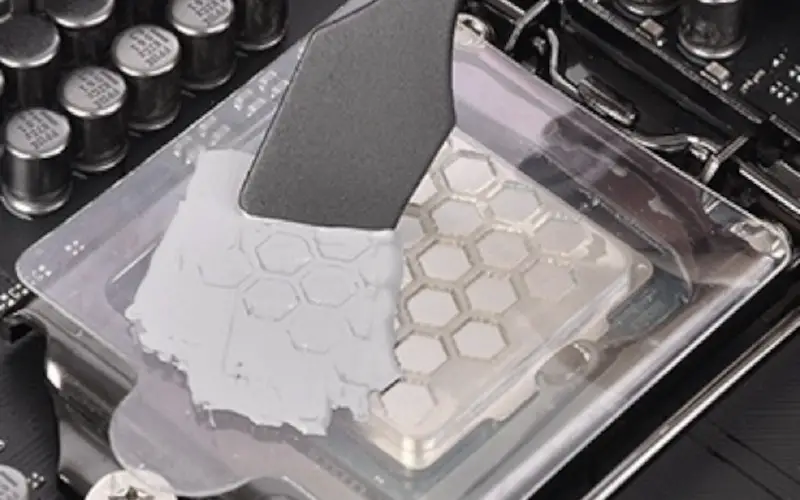Anyone who has ever upgraded or replaced a component in their computer will know of thermal paste. This sticky, white substance’s purpose is to transfer heat away from the processor, so it doesn’t overheat. By dissipating heat and keeping the processor cool, it helps prevent any damage that could be caused by overheating.
No, thermal paste is not toxic. It consists of materials like zinc oxide, aluminum oxide, and silicon dioxide – all of which are safe for human exposure, according to numerous sources.
You shouldn’t eat thermal paste, but if it gets on your skin by accident, don’t worry. It’s not harmful. Remember to wash it off with soap and water when you’re done using it.
What Happens If You Eat Thermal Paste?
If you eat thermal paste, you may experience gastrointestinal distress. Symptoms may include nausea, vomiting, and diarrhea. If you have eaten a large amount of thermal paste, you may additionally experience confusion, headaches, and dizziness.
If you experience any of the symptoms mentioned above, seek medical attention immediately. Thermal paste is not considered poisonous but can cause serious health problems if consumed in large quantities.
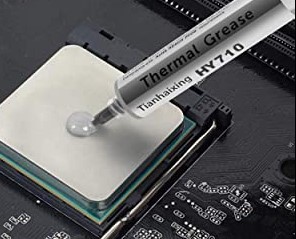
You should also avoid contact with thermal paste. If the paste gets on your skin, wash it off immediately with soap and water. If you get the paste in your eyes, flush them with water for at least 15 minutes. If you experience any irritation, seek medical attention immediately.
Thermal paste is used to conduct heat away from sensitive electronic components.
It is often used on CPUs and GPUs. Thermal paste comprises metal oxides, conducting particles, and a binding agent. It is important to use the correct type of thermal paste for your application to ensure proper heat transfer.
Does Thermal Paste Contain Mercury?
Although you might think that thermal paste contains mercury, it does not. This substance is made of different materials; however, mercury is not one of its ingredients.
Thus, if you want an eco-friendly way to stop your computer from overheating, then using this paste would be ideal. Most hardware stores sell thermal paste, and it’s simple enough to apply – just make sure to read the directions on the package before doing so!

What Does Thermal Paste Contain?
Thermal paste is a substance used to help transfer heat between two surfaces. It is often used in electronic devices to dissipate heat from components such as CPUs and GPUs.
Thermal paste usually consists of a metal oxide or silicon dioxide powder suspended in a liquid medium such as water, oil, or alcohol. Some brands of thermal paste also contain additives such as conductive fillers or anti-oxidants.
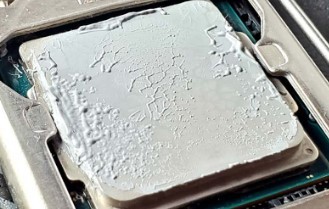
How Does Thermal Paste Work?
Thermal paste creates a thin layer of conductive material between two surfaces. This conductive layer helps to dissipate heat away from sensitive components and prevents them from overheating.
Thermal paste is often used to improve the thermal contact between a heat sink and a CPU or GPU.
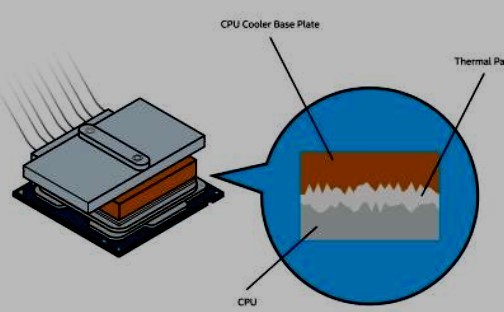
The thermal paste fills in the microscopic imperfections on the CPU’s or GPU’s surface. These imperfections can create small pockets of air that act as insulators, preventing heat from being transferred efficiently. The thermal paste helps to eliminate these pockets of air and creates a more direct path for heat to travel.
Thermal paste comprises various materials, including metal oxides, ceramic powders, and diamond dust. The specific composition of the thermal paste can vary depending on the manufacturer.
The most important factor in thermal paste is its ability to conduct heat. The thermal conductivity of a material is measured in watts per meter-kelvin (W/mK). The higher the thermal conductivity, the better the material dissipates heat.
Thermal paste typically has a thermal conductivity of between 2 and 8 W/mK. The best thermal pastes on the market can have conductivities of up to 14 W/mK.
Thermal paste is applied directly to the surface of the CPU or GPU. A small amount is usually needed; too much thermal paste can impede heat transfer.
Once the thermal paste is applied, it must be spread evenly over the component’s surface. This can be done with a finger, a credit card, or a special tool called a thermal paste spreader.
After the thermal paste is applied, the heat sink is attached to the CPU or GPU. The heat sink helps to dissipate heat away from the component and prevents it from overheating.
What Happens If You Accidentally Touched Thermal Paste?
It is not the world’s end if you accidentally touch thermal paste. However, cleaning it immediately and properly is important to avoid damaging your equipment.
Thermal paste is a heat conductor that helps transfer heat away from sensitive electronic components. It is typically used between a computer processor and a heatsink.
If you accidentally touch thermal paste, the first thing you should do is wash your hands thoroughly with soap and water. This will remove any oils or other contaminants from your skin that could damage electronic components.
Once your hands are clean, you can use a lint-free cloth to wipe away the thermal paste. If the paste is difficult to remove, you can use isopropyl alcohol to help break it down.
Once the thermal paste is removed, you should apply a new layer to the processor and heatsink. Make sure that the paste is spread evenly to ensure optimal heat transfer.
Can I Spread Thermal Paste With My Finger?
You can, but it’s not the best way to do it. Your fingers have oils on them that can cause the thermal paste not to work. It’s better to use a piece of cardboard or something similar to spread the paste. If you do use your fingers, make sure you wash them first.
Can I Use Water To Clean Thermal Paste?
If you’re using a water-based thermal paste, it’s perfectly fine to use water to clean it off. However, you should avoid using water on oil-based thermal pastes, as it can cause the paste to degrade and become less effective.
If unsure what type of thermal paste you’re using, check the manufacturer’s instructions before cleaning.
In general, it’s best to clean the thermal paste off with a dry, lint-free cloth. If you need to use water, dry the area thoroughly afterward to prevent any water from getting into your computer.
What Can I Use To Clean Off Thermal Paste?
There are several ways to clean off the thermal paste, and the method you choose will likely depend on what materials you have on hand. The following are some common methods:
- Use a clean, dry cloth to wipe away the thermal paste. This is the simplest method, but it may not remove all of the paste.
- Use rubbing alcohol or a similar solvent to break down the thermal paste. This method will require some scrubbing, but it should be effective.
- Use a commercial thermal paste remover. These products are designed specifically for removing thermal paste and should be very effective.
Whichever method you choose, be sure to clean the surface thoroughly before applying the new thermal paste.
Can You Inhale Thermal Paste?
You should not inhale thermal paste. Inhaling the fumes from thermal paste can be harmful to your health. If you must work with thermal paste, be sure to work in a well-ventilated area. Wear a mask if possible, and avoid inhaling the fumes from the thermal paste.
If you accidentally inhale thermal paste, seek medical attention immediately. Thermal paste can cause burns to the lungs if inhaled. In severe cases, it can even lead to death.
So, if you accidentally inhale thermal paste, get to a hospital as soon as possible in case you need treatment.
In general, it’s best to avoid inhaling any fumes. If you must work with harmful chemicals, always take precautions to avoid inhaling them. And if you do accidentally inhale something harmful, seek medical attention immediately.
What Does Thermal Paste Taste Like?
Thermal paste is a substance that helps to conduct heat away from sensitive components in electronic devices. Thermal paste is usually made of metal oxides, silicones, or conductive polymers.
Some people report that thermal paste has a metallic taste. Others say it tastes sweet or faintly of chemicals. It is possible that the thermal paste is reacting with the metal in the heat sink and producing a metallic taste. Alternatively, the sweet or chemical taste could be due to the additives in the paste.
If you accidentally taste thermal paste, it will not likely cause any harm. However, it is best to avoid contact with the substance if possible.
If you do come into contact with thermal paste, be sure to wash your hands thoroughly afterward. Ingesting large amounts of thermal paste could be harmful, so it is best to avoid swallowing it.
Does Thermal Paste Melt?
Thermal paste is a material that fills the gaps between a CPU and its heat sink. The main purpose of thermal paste is to improve the contact between these two surfaces, increasing heat transfer efficiency. Thermal paste comprises various materials, but silicone is the most common and effective ingredient.
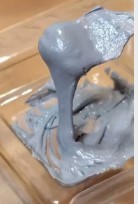
One of the properties of silicone is its very low melting point. If the temperature gets too high, the thermal paste will melt. However, this is not a cause for concern as the melting point of silicone is still significantly lower than the operating temperatures of most CPUs.
So, the thermal paste should not melt unless your CPU runs at an unusually high temperature.
If the thermal paste does melt, it will re-solidify once the temperature drops below its melting point. This means there is no need to worry about the thermal paste permanently damaging your CPU.
However, if the thermal paste melts repeatedly, it can degrade and become less effective. Therefore, avoiding running your CPU at excessively high temperatures is best.
How Hot Can Thermal Paste Get?
The answer to this question largely depends on the thermal paste you use. For example, metallic-based thermal pastes can handle much higher temperatures than non-metallic ones. That being said, most thermal pastes are rated to withstand temperatures up to 200°C (392°F).
Some high-end thermal pastes can even withstand temperatures up to 350°C (662°F). Still, these are typically only used in very specific applications, such as CPUs that are overclocked to extremely high speeds.
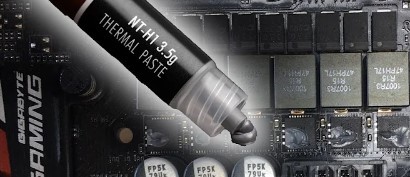
You shouldn’t have to worry about your thermal paste getting too hot. Unless you’re doing something that is pushing your CPU to its absolute limits, the thermal paste should be just fine.
Of course, if you are concerned about your thermal paste getting too hot, you can always try using a lower-temperature paste. These are typically made from materials that can withstand higher temperatures, such as ceramic or diamond.
Do You Need Gloves For Thermal Paste?
You don’t need gloves for thermal paste, but you might want to use them anyway. They’ll keep your hands clean and prevent the paste from getting on anything else. You can also buy thermal paste in a tube that is easy to apply and doesn’t require special tools or equipment.
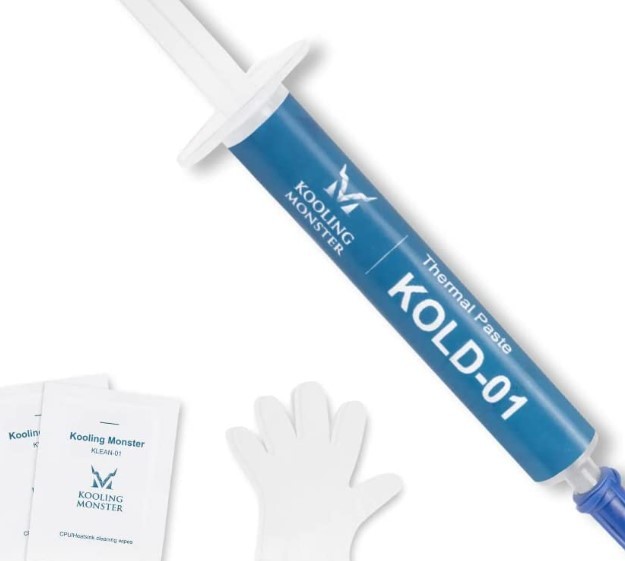
Some people prefer to use a credit card or other thin, stiff object to spread the thermal paste. This can work well, but be careful not to damage the CPU or other sensitive components.
Once you’ve applied the thermal paste, you can install the heatsink and fan. Make sure everything is secure and there are no loose parts. Then, connect the power and boot up your computer.
Is Thermal Paste Toxic To Dogs?
No, thermal paste is not toxic to dogs. It is safe for all mammals. Thermal paste is used to help conduct heat away from sensitive components and into a heatsink or cooling device. It is typically made from a silicone compound and is non-toxic.
If your dog ingests thermal paste, there may be some gastrointestinal upset, but it is not expected to cause serious health problems. If you are concerned, please get in touch with your veterinarian.
Is Thermal Paste Toxic To Cats?
No, thermal paste is not toxic to cats. However, if your cat ingests thermal paste, it may experience gastrointestinal irritation and vomiting. If your cat ingests a large amount of thermal paste, it may experience more serious health problems, such as liver damage.
Contact your veterinarian immediately if you think your cat has ingested thermal paste.
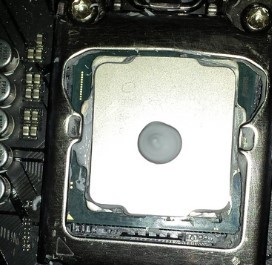
Conclusion
You must be careful when handling thermal paste, as it can be toxic if ingested. Inhaling the fumes can also be harmful. If you come into contact with the substance, wash your hands and face thoroughly.
Overall, though, thermal paste is a safe product to use for your computer. Just be sure to use it in a well-ventilated area and take precautions when handling it.

